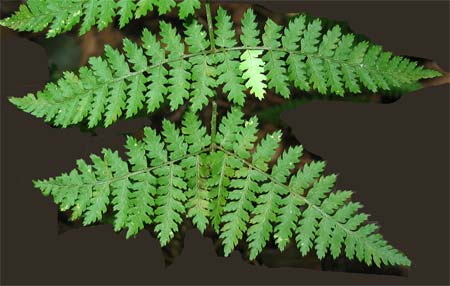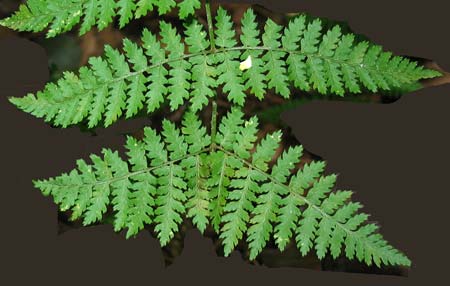Fern
Glossary |
| |
| In order to discuss ferns, one needs to
become acquainted with fern terminology, which is unique to the study of
ferns. In keeping with the philosophy of this website of making the
study of ferns accessible to non-scientific naturalists, scientific
terminology is kept to a minimum on this website. However, the use of
some specialised terminology is necessary in order to talk intelligently
about ferns. The terms used in this website are explained and
illustrated below.
|
|
|
- SPORES
- SPORANGIUM / SPORANGIA
- SORUS / SORI
- INDUSIUM
Ferns do not have flowers or seeds. Instead they reproduce by
means of SPORES. SPORES are tiny dust-like
particles that grow in and are released from structures called
SPORANGIA (singular: SPORANGIUM; plural: SPORANGIA).
A group of SPORANGIA is called a SORUS (singular:
SORUS; plural: SORI).
SORI are sometimes covered by a flap referred to as an
INDUSIUM.
In this photo of
Marginal Shield Fern (Dryopteris marginalis)
are several SORI, each one of which is
covered by an INDUSIUM. The middle leaflet has seven
SORI. |
|
|
The SPORANGIA are the small black or green balls that can be seen
peeking out from under the INDUSIUM. So, to summarize ... SPORANGIA
cluster together in groups called SORI; SORI are sometimes covered by a
flap called the INDUSIUM.
The shape, location and pattern of SORI on the underside of fern
frond leaflets can be an important identifying characteristic. For
example, in the photo above, the fact that the SORI are arranged along
the very edge of the leaflet identifies this fern as a
Marginal Shield Fern (Dryopteris marginalis).
But not all ferns carry their SORI in this location. Many have
separate fertile leaflets, or even a completely separate and distinct
fertile frond or stalk.
For example, below on the left is
Cinnamon Fern (Osmundastrum cinnamomeum),
which has an entirely separate fertile stalk carrying
the SORI. On the right is
Interrupted Fern (Osmunda claytoniana),
which carries its SORI on fertile leaflets partway
up the regular fronds. |
|
|
|
|
|
- FROND
- BLADE
- STALK / STIPE
FROND refers to the whole fern "leaf" that rises from the
roots. In this photo of a herbarium specimen of a Marginal
Shield Fern, the FROND is the entire plant seen except for the
root.
The BLADE is the portion of the FROND that carries the
leaflets - it is above the STALK / STIPE. In the photo, the
BLADE is the upper portion arching towards the upper right.
The STALK or STIPE is the portion of the FROND that is below
the leaflets - it is below the BLADE. In this photo, the STALK /
STIPE is the lower portion bent to the lower right.
STALK and STIPE refer to the same thing; STIPE is a more
correct term than STALK. |
|
|
|
|
|
|
|
|

Intermediate Wood Fern (Dryopteris intermedia)
|
PINNAE or LEAFLETS may be further
divided into PINNULES or SUBLEAFLETS. This photo has one
PINNULE or SUBLEAFLET highlighted.
PINNULES or SUBLEAFLETS are present on a twice-divided or
twice-cut fern. |
|
|

Intermediate Wood Fern (Dryopteris intermedia)
|
PINNULES OR SUBLEAFLETS may be
further divided into LOBES or SUB-SUBLEAFLETS. This photo has
one LOBE highlighted (part of the PINNULE that is highlighted in
the previous photo).
LOBES are present on a thrice-divided or
thrice-cut fern. |
|
|
|
|
FIDDLEHEAD is the name given to the emerging fern plant in
the spring. It is so named for its resemblance to the end of a
violin, or fiddle.
This photo shows FIDDLEHEADS of
Ostrich Fern (Matteuccia struthiopteris).
|
|
|
|
|